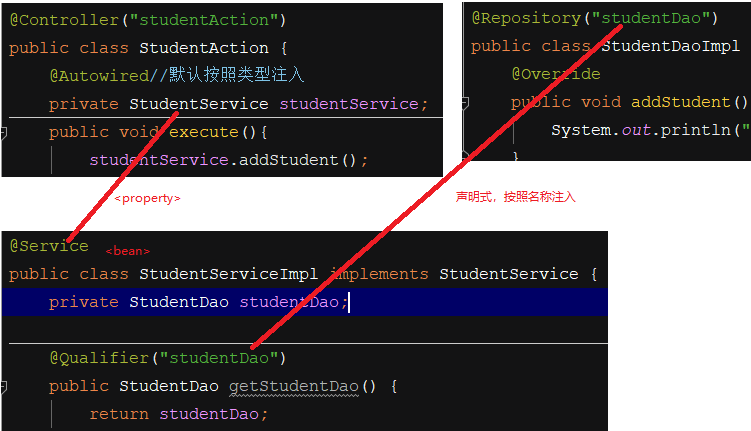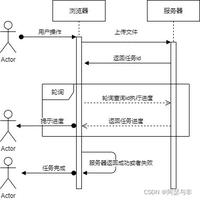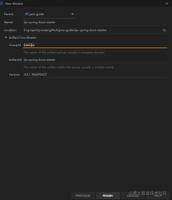spring注解(Component、依赖注入、生命周期、作用域)
本文内容纲要:spring注解(Component、依赖注入、生命周期、作用域)
1、注解
注解就是一个类,使用@加上注解名称,开发中可以使用注解取代配置文件
2、@Component 取代
(1)创建一个类(该类与dao层无联系,是一个单独的类)
@Component("studentService")public class StudentServiceImpl implements StudentService {
public void addStudent(){
System.out.println("StudentService的实现类的Add方法!!");
}
}
(2)创建配置文件:
<?xml version="1.0" encoding="UTF-8"?><beans xmlns:xsi="http://www.w3.org/2001/XMLSchema-instance"
xmlns:context="http://www.springframework.org/schema/context"
xmlns="http://www.springframework.org/schema/beans"
xsi:schemaLocation="http://www.springframework.org/schema/beans
http://www.springframework.org/schema/beans/spring-beans-4.2.xsd
http://www.springframework.org/schema/context
http://www.springframework.org/schema/context/spring-context.xsd">
<context:component-scan base-package="pers.zhb.service"></context:component-scan>
</beans>
(3)测试类:
public class TestCycle { public static void main(String[] args) {
ApplicationContext applicationContext=new
ClassPathXmlApplicationContext("applicationContext.xml");//创建容器对象
StudentService studentService= (StudentService) applicationContext.getBean("studentService");
studentService.addStudent();
}
}
(4)web开发中,提供了3个@Component注解的衍生注解(功能一样),它们是spring框架为我们提供的三层使用的注解,使得我们的三层对象更加清晰
@Repository:dao层(持久层)与@Mapper的区别是,@resposity需要配置扫描,而@Mapper不需要它是利用的XML里的NameSpace
@Service:service层(业务层)
@Controller:web层(表现层)
(5)@Component注解
作用:用于把当前类的对象存入到spring容器中
属性:
value:指定bean的id,不写的时候默认是当前的类名,且首字母小写。当指定属性的值的时候就要用该值
3、依赖注入
(1)创建一个Action:
@Controller("studentAction")public class StudentAction {
@Autowired//默认按照类型注入
private StudentService studentService;
public void execute(){
studentService.addStudent();
}
}
使用@Autowired注解(依赖注入)的时候可以写在属性或set方法处,写在属性处可以节省代码量,优先按照bean的类型去找。
(2)service层:
public interface StudentService { public void addStudent();
}
@Service
public class StudentServiceImpl implements StudentService {
private StudentDao studentDao;
@Qualifier("studentDao")
public StudentDao getStudentDao() {
return studentDao;
}
@Autowired
public void setStudentDao(StudentDao studentDao) {
this.studentDao = studentDao;
}
public void addStudent(){
studentDao.addStudent();
}
}
(3)dao层:
public interface StudentDao { public void addStudent();
}
@Repository("studentDao")
public class StudentDaoImpl implements StudentDao {
@Override
public void addStudent() {
System.out.println("StudentDao的实现类的Add方法!!");
}
}
(4)配置文件:
<?xml version="1.0" encoding="UTF-8"?><beans xmlns:xsi="http://www.w3.org/2001/XMLSchema-instance"
xmlns:context="http://www.springframework.org/schema/context"
xmlns="http://www.springframework.org/schema/beans"
xsi:schemaLocation="http://www.springframework.org/schema/beans
http://www.springframework.org/schema/beans/spring-beans-4.2.xsd
http://www.springframework.org/schema/context
http://www.springframework.org/schema/context/spring-context.xsd">
<!--扫描-->
<context:component-scan base-package="pers.zhb"></context:component-scan>
</beans>
(5)测试:
public class ActionTest { public static void main(String[] args) {
ApplicationContext applicationContext=new
ClassPathXmlApplicationContext("applicationContext.xml");//创建容器对象
StudentAction studentAction= (StudentAction) applicationContext.getBean("studentAction");
studentAction.execute();
}
}
StudentDao的实现类的Add方法!!

@Autowired
- 可以省略类内的get和set方法以及配置文件中bean的依赖注入的内容,但是在spring容器中还是需要配置bean的,可以结合生成bean的注解使用
- 自动按照类型注入,只要容器中有唯一一个bean对象类型和要注入的变量类型匹配,就可以注入成功
- 出现的位置可以是变量上也可以是方法上
- 按照类型注入的时候,如果有多个可以注入,不能注入成功的时候,可以按照名称注入(需要手动修改注入的变量名称),例如,一个接口有多个实现类,那么这些实现类就是相同类型的,注入的时候会出现问题,因为注入的时候匹配到了多个bean

@Qualifier
属性value用于指定注入的bean的id
在给类成员注入的时候不能独立使用,也就是说要和Autowired注解配合使用。当有多个相同类 型 的 bean 却只 有 一个需 要 自 动 装 配 时 , 将 @Qualifier 注 解 和@Autowire 注解结合使用以消除这种混淆, 指定需要装配的确切的 bean。
@Resource
直接按照bean的id注入,可以独立使用
属性可以指定bean的id
以上三种注解都是能用于注入bean类型的数据,而基本类型和String类型无法使用上述注解
@Value:用于注入基本类型和String类型,属性用于指定值
@Required :如果你在某个java类的某个set方法上使用了该注释,那么该set方法对应的属性在xml配置文件中必须被设置,否则就会抛出BeanInitializationException。
4、生命周期
初始化:@PostConstruct
销毁:@PreDestory
分别添加到初始化和销毁方法之前。
5、bean的作用域
(1)单例对象singleton(缺省)

测试:
Student student1 =(Student)applicationContext.getBean("student"); Student student2 =(Student)applicationContext.getBean("student");
System.out.println(student1==student2);
返回结果为true,说明创建的是同一个对象。在spring容器中只存在一个bean的实例,bean以单里的形式存在
(2)多例对象prototype

测试:
Student student1 =(Student)applicationContext.getBean("student"); Student student2 =(Student)applicationContext.getBean("student");
System.out.println(student1==student2);

返回的结果为false,创建的是两个不同的对象。每次调用getBean()的时候都会返回一个新的实例
(3)request
request: 每次 http 请求都会创建一个 bean, 该作用域仅在基于 web 的 Spring ApplicationContext 情形下有效
(4)session
session: 在一个 HTTP Session 中, 一个 bean 定义对应一个实例(同一个Session共享一个Bean实例)。 该作用域仅在基于 web 的 Spring ApplicationContext 情形下有效。
(5)global-session
global-session:同session作用域不同的是,所有的Session共享一个Bean实例。 该作用域仅在基于 web 的 Spring ApplicationContext 情形下有效。
本文内容总结:spring注解(Component、依赖注入、生命周期、作用域)
原文链接:https://www.cnblogs.com/zhai1997/p/12696197.html
以上是 spring注解(Component、依赖注入、生命周期、作用域) 的全部内容, 来源链接: utcz.com/z/296373.html








